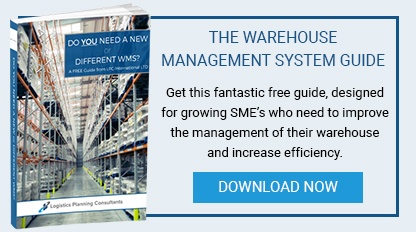
After reading our previous article, on the 'benefits of a warehouse management system', you may have begun to consider the improvements a WMS can make in your warehouse and supply chain. But what about implementing the system? Implementing such a wide ranging and important system as a WMS comes with its fair share of risk, if it is not properly planned. At many different points, something can go wrong that risks derailing or delaying the process, costing you money and lost productivity.
Before you consider implementing your new WMS, or even before you start shopping around seriously, it helps to have a draft implementation roadmap in place so that all the stakeholders in your business can go into the process with confidence.
Below you will find our suggested five point roadmap. This isn’t an implementation blueprint – for this you will need a bespoke plan tailored to the needs of your company – but we hope it provides questions that allow you to give full consideration to what is involved.
1) What Sort Of WMS Will You Be Implementing?
The term ‘Warehouse Management System’ does not describe a single type of software. Implementation will therefore vary based on the type of WMS you choose. For instance, you may be considering a stand-alone WMS that interacts with, but does not replace your current business systems. Or, if you already use an ERP, you may be able to implement a WMS module from your current provider.
Before deciding what system works best for you, it is helpful to conduct a business review; analysing your current warehouse processes, resourcing and costs, to see where improvements can be made. These set the criteria for what you need the WMS to perform. From here you can take a look at off-the-shelf and bespoke options to see what best suits your requirements. Most warehouse management systems can be customised prior to implementation, so understand what you want and don’t compromise on core functions in so far as your budget allows.
A different project plan will be required for each different system, the goal being to minimise disruption during implementation and ensure you can continue to receive, store and dispatch goods from your warehouse while the system is being installed.
2) Setting Expectations: Who Needs To Be Involved?
A WMS will mean different things to different stakeholders within the business. Set expectations to determine what each group expects from the WMS and use this to plan what you need to do to ensure their needs are met. This ensures stakeholder buy in – if people in the company are unsure of what the WMS will do, or are not committed to the process, then it can really hold up implementation.
Most warehouse-operating businesses have four groups of stakeholders that need consideration when implementing a WMS:
- Warehouse operatives: want the WMS to make their work easier and help them avoid errors. They also need reassurance that the WMS will not add to their workload (e.g. through extra admin) or put their jobs at risk.
- Warehouse managers and supervisors: have a lot to do with their time, so need a user-friendly system that is good at streamlining inefficient processes and ironing out bad practices.
- The IT manager who will have to ensure that it communicates efficiently with the other systems and that the correct integration and signals between them are correct.
- Senior managers, including directors and logistics managers: look for a cost-effective system that gives them a good ROI, with a quick and painless implementation process.
3) Setting A Realistic Schedule For Implementation
Implementation doesn’t happen overnight. It is all too tempting to set unrealistically short expectations for implementation that then fail to materialise, causing issues and disruption. The problem is that implementation involves a multipoint schedule, each stage of which is vulnerable to delays. The solution is to build a flexible implementation schedule that gives you room for manoeuvre, fall back positions and an alternative plan if the unforeseen happens.
While planning for the best outcome, it also pays to be realistic about risk. What are all the scenarios where things can go wrong? What about the health and safety implications of the implementation? Exploring and planning for worst case scenarios lets you be prepared to face and overcome whatever challenges the implementation brings.
If other works are happening such as the installation of new equipment or a facilitiy they should be taken into account in the planning and an overall master plan created and risks assessed.
4) Managing The Implementation
During the implementation itself you will need two teams of people working in your warehouse: the implementation team and your Business as Usual (BAU) team. Most businesses do not have the luxury of ceasing operations while their WMS is installed, so a plan needs to be devised to ensure continued operations during implementation. Both teams need to communicate and work together flawlessly, and their actions have to be managed closely; because when the time for deployment comes, there will be little margin for error. Working through different role-play scenarios together will help you understand the potential difficulties you may face during deployment and establish the criteria for success. You may need to modify your implementation plan based on these findings.
5) Training
Ensure that all stakeholder groups receive sufficient training in the WMS with plenty of time to spare before implementation. Depending on your vendor, this may take one or two days for each group and need to be staggered. It can be a significant investment in time but is worth it in the long run, as it reduces the risk of confusion during implementation, and minimises the time it takes to return to full efficiency when your new system is in place. It is normal for the vendor to train your trainers, who then train the operatives and managers.
Professional Support During Implementation
With the best will in the world, the implementation and deployment process frequently reveals issues that were not understood during the planning process. The professional support of a logistics expert, such as LPC, can therefore be a valuable asset before, during and after implementation. We can use our industry knowledge and experience to offer you personalised consultancy that smooths the implementation process and ensures all potential issues are addressed.
To find out more about warehouse management systems and how they can benefit your operation, download a free copy of our Warehouse Productivity Guide and WMS e-book. Our new e-book give professional advice to SMEs looking to streamline or expand their warehouse operation, with benefits and efficiencies that extend throughout the supply chain. Click here to download your copy.


